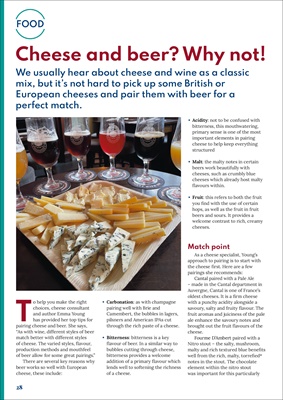
28
FOOD
Cheese and beer? Why not!
We usually hear about cheese and wine as a classic
mix, but it's not hard to pick up some British or
European cheeses and pair them with beer for a
perfect match.
To help you make the right
choices, cheese consultant
and author Emma Young
has provided her top tips for
pairing cheese and beer. She says,
"As with wine, different styles of beer
match better with different styles
of cheese. The varied styles, flavour,
production methods and mouthfeel
of beer allow for some great pairings."
There are several key reasons why
beer works so well with European
cheese, these include:
• Carbonation: as with champagne
pairing well with Brie and
Camembert, the bubbles in lagers,
pilsners and American IPAs cut
through the rich paste of a cheese.
• Bitterness: bitterness is a key
flavour of beer. In a similar way to
bubbles cutting through cheese,
bitterness provides a welcome
addition of a primary flavour which
lends well to softening the richness
of a cheese.
• Acidity: not to be confused with
bitterness, this mouthwatering,
primary sense is one of the most
important elements in pairing
cheese to help keep everything
structured
• Malt: the malty notes in certain
beers work beautifully with
cheeses, such as crumbly blue
cheeses which already host malty
flavours within.
• Fruit: this refers to both the fruit
you find with the use of certain
hops, as well as the fruit in fruit
beers and sours. It provides a
welcome contrast to rich, creamy
cheeses.
Match point
As a cheese specialist, Young's
approach to pairing is to start with
the cheese first. Here are a few
pairings she recommends:
Cantal paired with a Pale Ale
- made in the Cantal department in
Auvergne, Cantal is one of France's
oldest cheeses. It is a firm cheese
with a punchy acidity alongside a
savoury, salty and fruity flavour. The
fruit aromas and juiciness of the pale
ale enhance the savoury notes and
brought out the fruit flavours of the
cheese.
Fourme D'Ambert paired with a
Nitro stout - the salty, mushroom,
malty and rich textured blue benefits
well from the rich, malty, torrefied*
notes in the stout. The chocolate
element within the nitro stout
was important for this particularly